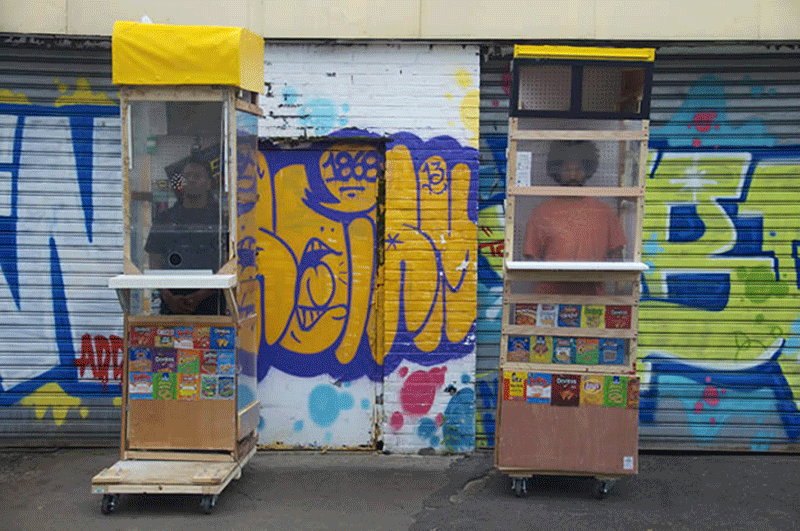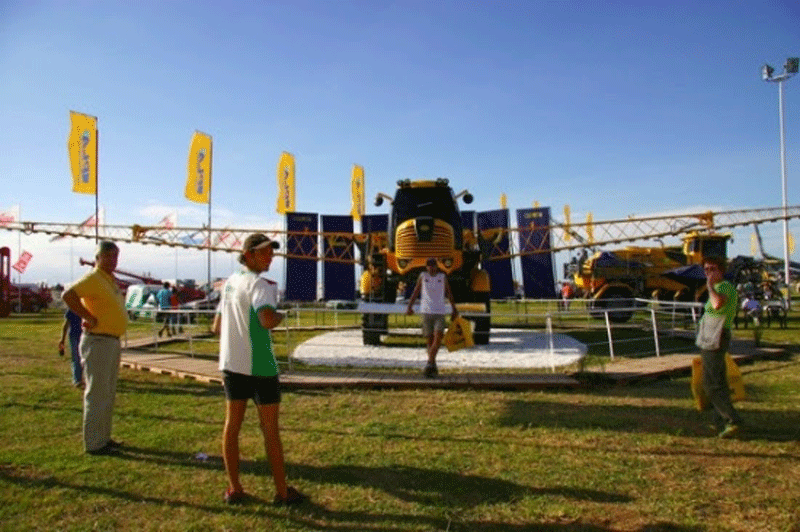 Image: Amber Art and Design, Corner Store Project
Image: Amber Art and Design, Corner Store Project
How Food Moves: Edible Logistics
Amber Art & Design / Ryan Griffis & Sarah Ross
Brian Holmes / Otabenga Jones & Associates / Cynthia Main
Claire Pentecost / Philly Stake / Stephanie Rothenberg
Candice Smith with Freedom Arts / Kristen Neville Taylor
Daniel Tucker, Guest Curator, Graduate Program Director in Social and Studio Practices at Moore College of Art and Design
March 27 – May 27, 2017
Public Program and Reception: Thursday, March 30, 2017, 6:00 – 8:30pm
Our public program begins at 6:00 pm followed by the reception
Rowan University Art Gallery, 301 High Street West, First Floor, Glassboro, NJ 08028
Admission to the gallery and reception is free and open to the public.
The public program begins at 6:00 pm, led by guest curator Daniel Tucker in dialogue on art, geography, and agricultural planning with Professor Megan Bucknum Ferrigno from Rowan University’s School of Geography and Environment, and with exhibiting artists.
Artists explore the US food supply chain and its complex patterns of distribution in between the point of origin (the farm) and its point of consumption (the plate). The exhibition aims to highlight the work of contemporary artists grappling with the complexity of this movement through multi-media, research-based, and participatory practices that focus a lens on the social and industrial impacts of migrant workers, food justice movements, immigration, multiculturalism, and economic disparities. This project builds upon Tucker’s event series, Moving Units: Where Food & Economy Converge. A companion booklet, produced by Rowan University Art Gallery, serves to provide a general overview of US food supply chains. It includes descriptions of the artist contributions to the exhibition that relate to each step on the chain. Throughout this booklet you read about an approach to geographic education that values connecting with the world outside the classroom. The booklet was researched and written by Megan Bucknum Ferrigno, part-time faculty member of Rowan University’s Department of Geography, Planning and Sustainability. Additional contributions made by Dr. Chuck McGlynn, Dr. Jennifer Kitson and Makenzie Franco.
About the Artists and Projects
With Corner Store, Amber Art & Design – a team of Philadelphia-based artists that work on public art within marginalized communities that have little or no access to art – explores the contemporary sociological and psychological intersection between pan-ethnic Black and Asian communities in Philadelphia and how relationships are shaped based on which side of the counter we stand. (image top)
Illinois-based artists Ryan Griffis and Sarah Ross are represented by Between the Bottomlands and the World, a video (combining photographs, narrative writing, and moving images) exploring the rural Midwestern town of Beardstown, IL, a place of global exchange and international mobility, inscribed by post-NAFTA (North American Free Trade Agreement) realities.
Brian Holmes, an art and cultural critic with a Ph.D. in Romance Languages has a long-standing interest in neoliberal globalization and a taste for on-the-ground intervention. His online atlas, Living Rivers, is devoted to the Mississippi and Great Lakes watersheds and shows these fluid ecosystems as they are inhabited by a multitude of creatures and radically altered by human enterprise.
Otabenga Jones & Associates, a Houston-based educational art organization, documents a collaborative art project and public health program addressing the ongoing crisis of obesity and its related risks with “The People’s Plate.” Inspired by the Black Panther Free Breakfast for School Children Program, this art project includes a public mural in Houston and programs to kick off a year-long commitment to health education.
Cynthia Main, a multidisciplinary artist from Missouri focuses on relating to the land as part of an integral view of a more sustainable society. She shares her hand-made buckets and barrels created using traditional techniques to readdress storage as one of the current dilemmas of localizing production.
Chicago’s Claire Pentecost uses photography to show how industrial agriculture is only partly about supplying food and how it is structured to meet the problem of expense and excess capital accumulation when considering the cost of complex machinery, brand name chemical herbicides, pesticides, fungicides, fertilizers, and patented seeds.
Philly Stake is a locally-sourced, recurring dinner that raises funds for creative and relevant community engaged projects that contributes to the well-being of Philadelphia’s neighborhoods through community arts, urban agriculture, social services, and activist work.
Stephanie Rothenberg’s Reversal of Fortune: The Garden of Virtual Kinship is a garden in the form of a global map that explores the question of what it means to be charitable through the click of a button and examines the cultural phenomena of online crowd-funded charity and how the flow of money impacts the project, positively and negatively.
Candice Smith runs Freedom Arts, an after school collaborative art program at Camden’s Freedom Prep Middle School, which is creating an installation responding to the idea that Camden is a “food desert” and examining the movement of food at their school and in their community.
Philadelphia-based Kristen Neville Taylor’s installation – a globe depicting routes of oranges and actual oranges outfitted with a QR code that links to music, articles, folk tales, and art – was inspired by a lyric from Leonard Cohen’s “Suzanne” (“and she feeds you tea and oranges that come all the way from China”) which she associated with the market place and the movement of food but also romance and exotic foreign cultures.
Admission to the gallery and reception is free and open to the public.
Free parking is now available in the parking garage on Mick Drive directly across from the gallery. For visitor information go to our website: www.rowan.edu/artgall
Thank you to Mary Salvante, Rowan University Art Gallery for the content of this post.
Like Rowan University Art Gallery on facebook
SEO and Photoshop by DoN.
Like DoNArTNeWs Philadelphia Art News Blog on facebook
Follow the new DoNArTNeWs.com
Follow DoN on Twitter @DoNNieBeat58
@donniebeat on Instagram
Affiliate Marketing [disclosure page] Shop on-line and help support DoNArTNeWs







